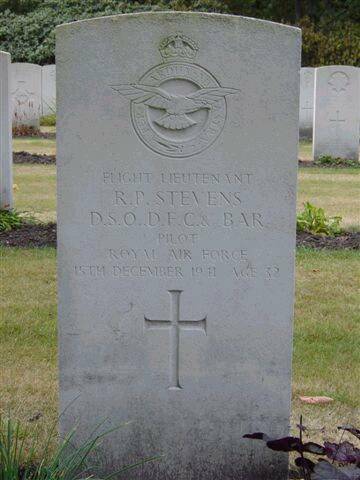Stevens, Richard Playne
- Date of birth:
- September 11th, 1909 (Tunbridge Wells)
- Date of death:
- December 15th, 1941
- Buried on:
- Commonwealth War Cemetery Bergen op Zoom
Plot: 23. Row: B. Grave: 4. - Service number:
- 87639
- Nationality:
- British
Biography
Richard Playne Stevens was educated at Hurstpierpoint College after which he went cattle farming in Australia. Tiring of this he joined the Palestine Police. After many adventures in the Middle East he returned home and settled in Shoreham where he was married and had several jobs. On the advice of his wife Olive he took flying lessons. Upon receiving his pilot license he was employed by Northeast Ailines flying air-taxis and freight. Then he joined Wrightways Air Services to fly night mail and newspapers to Paris. This was in 1937. He also joined the RAF Auxiliary Squadron in July 1937. On Paril 10 1940 he was accepted into the RAF. He was posted subsequently to No. 6 Anti-Aircraft Co-operation unit, 56 Operational Training Unit and finally to 151 Squadron at Digby which was a earmarked for night interception operations.
According to his colleagues, a solitary and melancholy man. If he was unable to fly he would stalk around the officer's mess, avoiding talking to anyone, before tucking into Seven Pillars of Wisdom. Joining No. 253 Squadron as a Flight Commander, Stevens was a pioneer of the night intruder mission. Having been awarded his D.S.O. on 12 December 1941, he set off again just three days later, but was killed in aerial combat over Gilze Rije air base but not before he shot down a Junkers Ju 88A-4 of III/KG 30.
Do you have more information about this person? Inform us!
- Period:
- Second World War (1939-1945)
- Rank:
- Pilot Officer
- Unit:
- No. 151 Squadron, Royal Air Force
- Awarded on:
- February 4th, 1941
"This officer has performed outstanding work on night fighting operations during recent weeks. One night in January, 1941, he shot down two hostile aircraft in the London area. In both these engagements he chased the enemy over 100 miles before destroying them at extremely short range. In one instance he followed the enemy aircraft almost to ground level from 30,000 feet.
He has shown the utmost keenness and determination for operations in all conditions of weather."
- Period:
- Second World War (1939-1945)
- Rank:
- Pilot Officer
- Unit:
- No. 151 Squadron, Royal Air Force
- Awarded on:
- May 2nd, 1941
"This officer has done particularly outstanding work with his squadron on night operations and has on three occasions shot down two enemy aircraft in one night. Pilot Officer Stevens shows a great determination to attack the enemy and is prepared to fly under the most difficult weather conditions. His courage, determination, thoroughness and skill have set an excellent example to his unit."
Second DFC awarded as a bar.
- Period:
- Second World War (1939-1945)
- Rank:
- Acting Flight Lieutenant
- Unit:
- No. 151 Squadron, Royal Air Force
- Awarded on:
- December 12th, 1941
"This officer has shown himself to be a fearless and outstanding night fighter pilot. One night in October, 1941, flying at sea level, he intercepted a Junkers 88 off the East Anglian coast. The raider immediately turned and flew towards the continent at maximum speed but Flight Lieutenant Stevens gave chase and slowly overhauled it. The raider then opened fire with his guns and began to drop his bombs singly. Columns of water were shot up as a result of the explosions but Flight Lieutenant Stevens swerved round them and,closing in to short range, shot down the enemy aircraft at almost sea level. He has destroyed at least 14 hostile aircraft at night."
Sources
- Photo: Hans Molier, The Netherlands
- - The London Gazette
Publication date:4 February 1941 Issue:35065Page:692
- The London Gazette Publication date:2 May 1941 Issue:35151Page:2511
- The London Gazette Publication date:9 December 1941 Supplement:35378Page:7052
- CWGC - Homepage
- FlyPast September 1996 page 72-73
- Spink & Son




